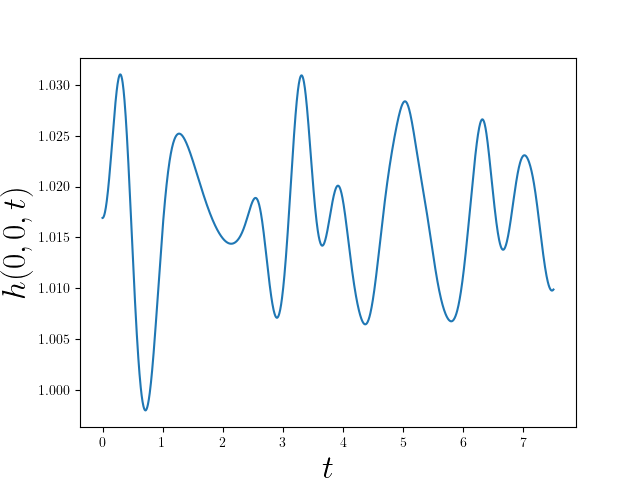2D Shallow water equations#
Simulates the 2D shallow water equations with conservative variables. The problem is described with the following system of PDE
for fluid column height \(h\), gravity \(g\) and 2D vector \((u, v)\) of the fluid’s horizontal flow velocity averaged across the vertical column.
Domain is \([-5,5]^2\) with slip-wall BCs
Initial conditions:
\(h = 1 + \alpha \exp( -(x-1)^2 - (y-1)^2)\)
\(u = 0\)
\(v = 0\)
Default settings:
\(\alpha = 1/8\) (initial pulse magnitude)
\(g = 9.8\) (gravity parameter)
\(\mu = -3.0\) (Coriolis parameter)
\(g, \mu, \alpha\) can be provided to the problem constructor (more below)
Mesh#
python3 pressio-demoapps/meshing_scripts/create_full_mesh_for.py \
--problem swe2dSlipWall_s<stencilSize> -n Nx Ny --outDir ...
where
Nx, Nyis the number of cells you want along \(x\) and \(y\) respectively<stencilSize> = 3 or 5 or 7: defines the neighboring connectivity of each cell<destination-path>is where you want the mesh files to be generated. The script creates the directory if it does not exist.
Important
When you set the <stencilSize>, keep in mind the following constraints (more on this below):
InviscidFluxReconstruction::FirstOrderrequires<stencilSize> >= 3InviscidFluxReconstruction::Weno3requires<stencilSize> >= 5InviscidFluxReconstruction::Weno5requires<stencilSize> >= 7
C++ synopsis#
#include "pressiodemoapps/swe2d.hpp"
int main(){
namespace pda = pressiodemoapps;
const auto meshObj = pda::load_cellcentered_uniform_mesh_eigen("path-to-mesh");
const auto scheme = pda::InviscidFluxReconstruction::FirstOder; //or Weno3, Weno5
// A. constructor for problem using default values
{
const auto probId = pda::Swe2d::SlipWall;
auto problem = pda::create_problem_eigen(meshObj, probId, scheme);
}
// B. constructor for problem specifying all coefficients
{
using scalar_type = typename decltype(meshObj)::scalar_t;
const scalar_type gravity = /* some value */;
const scalar_type coriolis = /* some value */;
const scalar_type alpha = /* some value */;
auto problem = pda::create_slip_wall_swe_2d_problem_eigen(meshObj, scheme,
gravity, coriolis, alpha);
}
}
Python synopsis#
import pressiodemoapps as pda
meshObj = pda.load_cellcentered_uniform_mesh_eigen("path-to-mesh")
probId = pda.Swe2d.SlipWall;
scheme = pda.InviscidFluxReconstruction.FirstOrder # or Weno3, Weno5
# A. constructor for problem using default values
problem = pda.create_problem(meshObj, probId, scheme)
# B. constructor for problem specifying all coefficients
gravity = # some value
coriolis = # some value
alpha = # some value
problem = pda.create_slip_wall_swe_2d_problem(meshObj, scheme, gravity, coriolis, alpha)
Sample Plot#
Representative plot of the height \(h(t)\) as a function of time at \(x=y=0\)
using default physical parameters, a 65x65 mesh with Weno5 and RK4 time integration:
